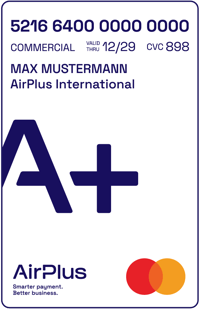eBook: the modern merchant model
Chapter 4: Why virtual credit cards are the payment solution for the merchant model
Why virtual credit cards are the payment solution for the merchant model
Virtual credit cards, designed specifically as a B2B payment solution for travel trade, are a crucial enabler in maximizing the benefits and adoption of the merchant model.
An effective strategy for B2B supplier payments can be just as important for travel intermediaries as their payment strategy toward their end customers when operating the merchant model, as they occupy a central position between the customer and the supplier.
It’s essential for travel intermediaries to have access to B2B payment options to ensure that the benefits also flow through to both the travel suppliers and the end customer. With the right B2B payment options, they can weigh the risks and costs of their activities as merchants of record. Without such options, these risks and costs go on to impact both travel suppliers and end customers. Virtual credit cards are the ideal solution for centrally controlling and managing B2B supplier expenses.

What are virtual credit cards?
Let’s take a closer look at what exactly virtual credit cards are all about. A virtual credit card is a 16-digit card number with a three-digit CVC code generated specifically for individual purchases. It can be a Mastercard® number, for example. Importantly, the card number loses its validity once it has been used.
Virtual credit card: these are its characteristics
High acceptance
By generating a virtual credit card number from the Mastercard® network, travel retailers can pay for all their travel services worldwide. For some perspective, the Mastercard network currently includes over 100 million acceptance points worldwide – all providers in this network would accept virtual Mastercard cards.7
Extremely secure
Each card number can be restricted to a specific booking and set to a specific amount, validity period, and currency. This ensures that virtual cards for travel trade businesses are both secure and flexible, especially for the intermediary’s booking agents, who handle multiple payments across numerous channels every day. Mastercard’s virtual credit cards also protect travel retailers against losses due to supplier default.
Combined billing instead of multiple individual invoices
All transactions made with virtual credit cards within a specified period are typically consolidated by the provider into a single, easy to understand statement and issued to the intermediary at the end of an agreed statement period. Suppliers, on the other hand, immediately receive payment from the provider.
The intermediary therefore receives a single statement instead of many individual invoices and has only one supplier: the virtual card provider.
Advantages of virtual credit cards for end customers
Using the merchant model with virtual credit cards for B2B payments enables travel intermediaries to build on the core benefits for end customers, with even more choice, better bundling, and less friction at check-out.
Under the merchant model, bundling individual trip components is smoother and easier with virtual cards for supplier payments. Customers can tailor their travel experience more effectively by offering a much wider range of options. The enhanced experience continues at check-out, as the end customer is billed only one amount for their trip, avoiding disparate charges from multiple suppliers.
Travel intermediaries are well placed to accept a variety of locally preferred payment options from their customers, which may be unique to their local jurisdictions or simply driven by local preferences. These can include different currencies or payment methods, such as bank transfers, credit cards, ‘Buy Now Pay Later’ (BNPL), and pre-payment installments.
Acceptance of these options by travel intermediaries ensures a smoother check-out experience for end customers. Travel intermediaries may be more willing to make the necessary investments for accepting these payment options and controlling fraud risks when they know they can easily make outgoing payments to travel suppliers using virtual credit cards – especially as they simplify their own payment operations.
Advantages of virtual credit cards for travel intermediaries
Travel intermediaries opt for the merchant model because, in addition to the better customer experience already mentioned, it allows them to increase their volume and leverage their capabilities in handling customer payments.
The ability to choose which currencies and payment types they accept from end customers enables them to effectively screen incoming payments for fraud.
In addition to the provided payment options, pricing is also (primarily) managed by the travel intermediary. This makes bundling, cross-selling, and up-selling easier in a merchant model. The wide variety of additional options, and demand generated via such offers, can deliver better value for all participants in the value chain.
Suppliers in this chain also benefit as there’s no need for them to accept the same payment combinations: virtual credit card payments effectively provide them with a payment guarantee. This already relieves the financial pressure on the travel intermediary’s business. In general, the financial pressure travel intermediaries face in their payment processes revolves around reconciling payment transactions and supplier invoices and securing cash flow.
Managing and controlling these two elements can be a major challenge for many travel retailers. Virtual credit cards help to address these issues as follows:
- Digital statements include all the necessary information for reconciling transactions and invoices, enriched with additional data in an easy-to-read overview
- A virtual credit card solution for travel trade combines credit lines and payment terms to significantly improve cash flow.

Availability of products varies by country due to regional regulations and market conditions. Please check local AirPlus website for current offerings.